#E-Commerce Disruption
Explore tagged Tumblr posts
Text
"Delhivery CEO: Quick Commerce Disrupting Kiranas"

Quick commerce platforms are having a greater impact on small retailers, or kiranas, than large e-commerce companies, according to Sahil Barua, CEO of logistics firm Delhivery. Speaking during a post-earnings call, Barua emphasized that while this view may not be widely accepted, quick commerce is disrupting kiranas more significantly than traditional e-commerce players within the broader retail ecosystem.
Delhivery’s revenue model is largely dependent on express parcel shipments, with a significant portion coming from e-commerce companies. Despite this, Barua noted that quick commerce, which focuses on ultra-fast deliveries. Read More
0 notes
Text
Unleashing the Future of E-Commerce: The Rise of Headless Commerce
Dive into the dynamic landscape of E-Commerce with our latest blog. Explore the disruptive potential of Headless Commerce and discover how it's reshaping the online shopping experience, unlocking unprecedented flexibility, and setting the stage for the future of digital retail.
#Headless Commerce#Future of E-Commerce#Digital Retail Trends#E-Commerce Innovation#Online Shopping Experience#E-Commerce Evolution#Headless CMS#Omnichannel Commerce#E-Commerce Flexibility#Decoupled E-Commerce#API-First Commerce#Progressive Web Apps (PWAs)#Microservices in E-Commerce#Frontend Development Trends#E-Commerce Disruption#Seamless Shopping Journeys#Next-Gen E-Commerce#Scalable E-Commerce Architecture#Future Retail Technologies#Headless Commerce Adoption
0 notes
Text
Preparing for Disruption: The Top Trends Innovating Business in 2024
In 2024, businesses face unprecedented opportunities and challenges, driven by rapid technological advancement and shifting consumer behaviors. "Preparing for Disruption: The Top Trends Innovating Business in 2024" provides insights into the emerging trends shaping the business landscape. Understanding these trends is not just vital for survival; it’s essential for thriving in an ever-evolving…
#best practices for brand management#Branding strategies for small businesses#building brand loyalty#Business#business growth strategies#corporate social responsibility#creating a strong brand identity#customer relationship management#digital marketing for startups#Disruption#e-commerce tips for businesses#how to scale your business.#how to start a successful business#importance of social media for businesses#influencer marketing for brands#Innovating#Preparing#small business funding options#Top#top business trends 2024#Trends
0 notes
Text
State of Logistics Report 2024
We now have the latest State of Logistics Report from Penske and Kearney in cooperation with the Council of Supply Chain Management Professionals (CSCMP). It’s a good piece of solid research. I was most interested in two specific aspects it presents. The first topic was the total United States Business Logistics Costs (USBLC) table. Logistics costs in 2023 actually shrank by 11% over the past…

View On WordPress
#3PL Sector Trends 2023#Asset-Heavy Logistics#CSCMP Logistics Research#E-commerce Logistics Costs#Geopolitical Impact on Logistics#Inventory Storage Costs 2023#Logistics#Logistics Coordination and Cooperation#Logistics Industry Cycles#Logistics Uncertainty and Disruption#Motor Carrier Costs 2023#Parcel Costs 2023#Penske and Kearney Logistics Report#Shippers&039; Administrative Costs Increase#supply chains#US Business Logistics Costs 2023#Warehouse Investment Trends
0 notes
Text
Changing Landscape of European Retail
Written By: Jagriti Shahi

Figure: Growth of retail in Europe
The retail industry in Europe has undergone significant transformations in recent years, driven by changing consumer preferences, technological advancements, and global economic shifts. From traditional brick-and-mortar stores to e-commerce giants, European retail has seen a remarkable evolution. In this article, we will explore the key trends shaping the changing landscape of European retail and how businesses are adapting to stay competitive in this dynamic environment. The retail sector in Europe is the largest in the world, with a turnover of over €2 trillion in 2021. The sector employs over 20 million people and accounts for about 10% of the EU's GDP. The retail sector in Europe is highly fragmented, with a large number of small and medium-sized enterprises (SMEs). However, there are also a number of large multinational retailers operating in the market, such as Carrefour, Tesco, and IKEA.
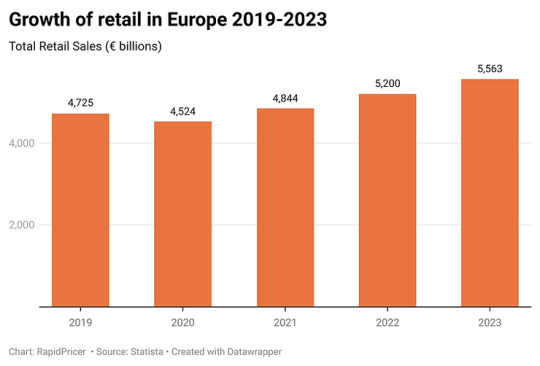
Figure: Growth of retail in Europe
The retail sector in Europe is facing a number of challenges, including the rise of e-commerce, the changing demographics of consumers, and the increasing adoption of new technologies. The rise of e-commerce is one of the most significant challenges facing the retail sector in Europe. In 2021, online retail sales in Europe reached €768 billion, accounting for 16.1% of total retail sales. This growth is being driven by a number of factors, including the increasing availability of high-speed internet, the growing popularity of mobile shopping, and the convenience of online shopping.
Traditional brick-and-mortar retailers are struggling to compete with the convenience and lower prices of online retailers. In order to survive, traditional retailers are investing in their online presence and offering omnichannel experiences that allow customers to shop online and in-store. The demographics of European consumers are also changing, which is having an impact on the retail landscape. The population is aging, with more people over the age of 65. This group is increasingly active and affluent, and they are looking for different products and services than younger consumers. They are also more likely to shop online.
Another demographic trend is the increasing diversity of the European population. This is leading to a demand for more ethnic food and clothing stores. Retailers are also adapting their marketing and advertising to reach these new customer groups.
New technologies are also having a major impact on the retail landscape. The use of artificial intelligence (AI), augmented reality (AR), and virtual reality (VR) is growing, and these technologies are being used to improve the customer experience in a number of ways. For example, AI can be used to personalize recommendations, AR can be used to try on clothes virtually, and VR can be used to create immersive shopping experiences. The adoption of new technologies is also creating new opportunities for retailers. For example, retailers can use data analytics to track customer behavior and improve their marketing and product offerings. They can also use social media to connect with customers and build relationships.
The future of European retail is uncertain, but it is clear that the industry is undergoing a major transformation. The rise of e-commerce, the changing demographics of consumers, and the increasing adoption of new technologies are all having a major impact on the way people shop. Retailers that are able to adapt to these changes will be the ones that are successful in the future.

Figure: Brick-and-Mortar stores
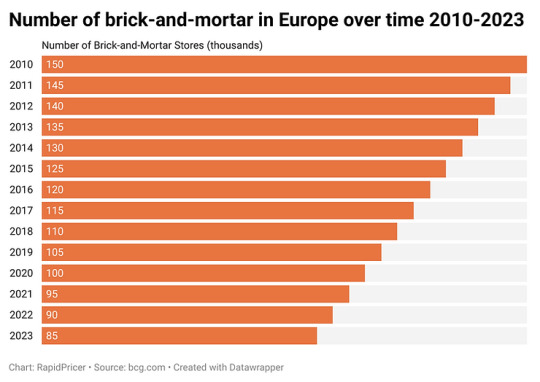
Figure: Number of brick-and-mortar in Europe over time

Figure: Department stores
Department stores: Department stores are large stores that sell a variety of products, such as clothing, home goods, and electronics. Some of the most famous department stores in Europe include Galeries Lafayette in Paris, Selfridges in London, and El Corte Inglés in Madrid.
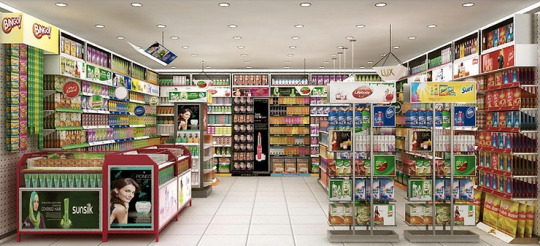
Figure: Independent retailers
Independent retailers: Independent retailers are small, privately owned businesses that sell a variety of products. These retailers often have a strong local presence and offer a unique shopping experience.
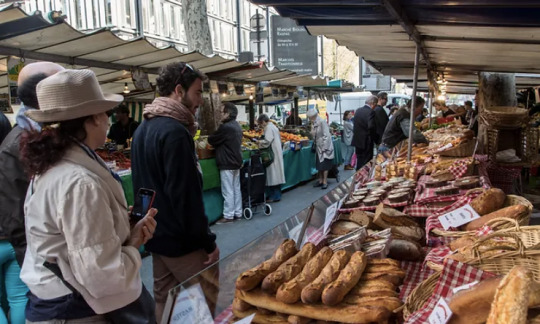
Figure: Markets
Markets: Markets are a great place to find fresh produce, meats, cheeses, and other local products. Many European cities have traditional markets that have been operating for centuries.

Figure: Outlet
Outlet malls: Outlet malls are a great place to find discounted name-brand clothing, shoes, and accessories. These malls are often located in tourist destinations.
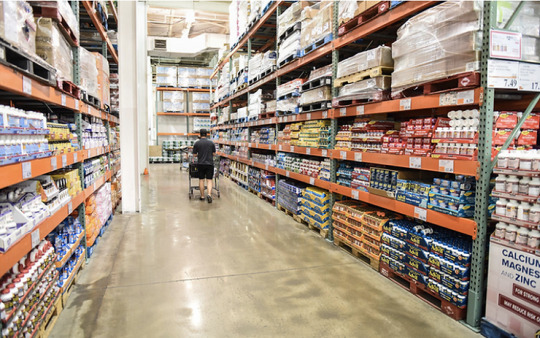
Figure: Warehouse clubs
Warehouse clubs: Warehouse clubs are membership-only stores that sell a variety of products in bulk. These clubs are a great place to find discounts on groceries, household goods, and other items.
Traditional retail is still a major part of the retail landscape in Europe, and it is likely to remain so for the foreseeable future. These stores offer a unique shopping experience that cannot be replicated online. In addition, many traditional retailers are adapting to the changing retail landscape by investing in their online presence and offering omnichannel shopping experiences.
The European Retail Landscape
Europe boasts a diverse and rich retail heritage, with traditional shops, boutiques, and markets dating back centuries. These establishments have played a significant role in local economies, offering consumers a wide range of goods and personalized shopping experiences.
Challenges in the Digital Age: Traditional retail in Europe has felt the impact of the digital age. The rapid growth of e-commerce giants like Amazon, along with the convenience of online shopping, has led to a decline in foot traffic at brick-and-mortar stores. Consumers now have access to a vast array of products with the click of a button, making it essential for traditional retailers to adapt.
The Omnichannel Approach: Many traditional European retailers are responding to the digital challenge by adopting an omnichannel approach. This strategy combines physical stores with an online presence, offering consumers a seamless shopping experience. Retailers are investing in e-commerce websites, mobile apps, and in-store technology to bridge the gap between offline and online shopping.
Customer Experience and Personalization: One advantage traditional retailers have over e-commerce is the ability to provide a unique and personalized customer experience. Many European consumers still value the tactile, sensory experience of shopping in a physical store. Traditional retailers are focusing on creating welcoming and interactive environments, offering personalized service, and curating their product selections to cater to local tastes.
Sustainability and Localism: In response to consumer demand for sustainability and ethical shopping, traditional European retailers are emphasizing their commitment to local sourcing and environmentally friendly practices. Some are rediscovering the benefits of locally-produced goods, promoting them as eco-friendly alternatives to mass-produced items. This aligns with the rising trend of supporting local businesses and reducing the carbon footprint associated with global supply chains.
Cultural and Historical Significance: Traditional retail establishments often hold cultural and historical significance in European communities. Many have been in operation for generations, serving as cornerstones of local culture. These stores are cherished by residents and tourists alike, and efforts are made to preserve their historical authenticity while integrating modern retail practices.
Government Support: Some European governments recognize the importance of preserving traditional retail and are offering support through grants, subsidies, and regulatory measures. These initiatives aim to bolster traditional retail against the encroachment of e-commerce and maintain the vibrancy of city centers.
Conclusion
Traditional retail in Europe is at a crossroads. While it faces challenges from the digital age and changing consumer preferences, it also has unique advantages rooted in history, culture, and personalized shopping experiences. To thrive in today's retail landscape, traditional retailers must embrace technology, adopt an omnichannel approach, focus on customer experience, and align with sustainability and localism trends. In doing so, traditional European retail can not only survive but also continue to offer consumers a distinctive and cherished shopping experience that reflects the rich tapestry of Europe's retail heritage. By adapting to the evolving market while preserving their unique qualities, traditional retailers can continue to play a vital role in the continent's commercial landscape.
The changing demographics of consumers
The demographics of European consumers are also changing, which is having an impact on the retail landscape. The population is aging, with more people over the age of 65. This group is increasingly active and affluent, and they are looking for different products and services than younger consumers. They are also more likely to shop online.
Another demographic trend is the increasing diversity of the European population. This is leading to a demand for more ethnic food and clothing stores. Retailers are also adapting their marketing and advertising to reach these new customer groups.
Here are some specific examples of how the changing demographics of consumers are impacting the retail industry in Europe:
The aging population is leading to a demand for more accessible and convenient shopping options. This is driving the growth of online grocery delivery and click-and-collect services.
The increasing diversity of the population is leading to a demand for more ethnic food and clothing stores. This is also leading to a demand for products and services that cater to the needs of diverse cultures, such as halal food and bilingual customer service.
The rise of the digital native is leading to a demand for more personalized and engaging shopping experiences. This is driving the growth of mobile commerce and augmented reality (AR) shopping.
The changing role of women is leading to a demand for more flexible shopping hours and options for online shopping. This is also leading to a demand for more products and services that are designed for women, such as maternity clothing and baby products.
The growing importance of sustainability is leading to a demand for more sustainable products and services. This is driving the growth of organic food, fair trade clothing, and recycled packaging.
The increasing adoption of new technologies
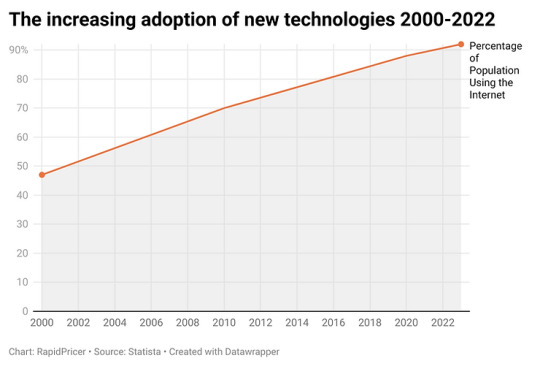
Figure: The increasing adoption of new technologies
As you can see, the percentage of people in Europe using the internet has been increasing steadily over the past two decades. This is due to a number of factors, including the increasing availability of high-speed internet, the falling cost of computers and smartphones, and the growing popularity of online services.
The increasing adoption of new technologies is having a major impact on the retail industry in Europe. Here are some of the key technologies that are being adopted by retailers in Europe:
Artificial intelligence (AI): AI is being used to improve a variety of tasks in the retail industry, such as customer service, inventory management, and fraud detection. For example, AI can be used to analyze customer data to personalize recommendations, or to predict which products are likely to be in high demand.
Augmented reality (AR): AR is being used to create immersive shopping experiences that allow customers to try on clothes virtually or see how furniture would look in their home. For example, IKEA has an AR app that allows customers to see how its furniture would look in their living room.
Virtual reality (VR): VR is being used to create even more immersive shopping experiences that allow customers to virtually visit stores and try on products. For example, Amazon has a VR store that allows customers to browse its products and make purchases.
Internet of Things (IoT): IoT is being used to connect devices and collect data about customer behavior. This data can be used to improve a variety of tasks, such as inventory management and customer service. For example, retailers can use IoT sensors to track the movement of products in stores and to identify when products are running low.
Blockchain: Blockchain is being used to create secure and transparent supply chains. This can help retailers to ensure the authenticity of their products and to track their products from the source to the customer. For example, Walmart is using blockchain to track the supply chain of its food products.
These are just some of the key technologies that are being adopted by retailers in Europe. The adoption of these technologies is helping retailers to improve their efficiency, personalize the customer experience, and create a more sustainable supply chain.
E-Commerce Dominance
One of the most profound shifts in European retail has been the rise of e-commerce. Consumers now have the convenience of shopping online from the comfort of their homes, and this trend has been accelerated by the COVID-19 pandemic. Major players like Amazon, Alibaba, and local champions such as Zalando and ASOS have expanded their reach across Europe, reshaping consumer behavior and expectations. Retailers have had to invest heavily in their online presence, enhancing websites, mobile apps, and supply chain logistics to meet the demand for digital shopping. Additionally, omnichannel strategies have become essential, allowing consumers to seamlessly switch between online and offline shopping experiences.
E-commerce dominance refers to the growing market share of online retailers over traditional brick-and-mortar stores. This trend is being driven by a number of factors, including the increasing availability of high-speed internet, the growing popularity of mobile shopping, and the convenience of online shopping. In Europe, e-commerce sales are expected to reach €768 billion in 2022, accounting for 16.1% of total retail sales. This growth is being driven by the increasing adoption of online shopping by consumers across all demographics.
There are a number of reasons why e-commerce is becoming so dominant. First, the availability of high-speed internet has made it possible for consumers to shop online quickly and easily. Second, the popularity of mobile shopping has made it possible for consumers to shop online from anywhere. Third, the convenience of online shopping is unmatched by traditional brick-and-mortar stores. Consumers can shop online 24/7, compare prices from different retailers, and have products delivered to their door. The rise of e-commerce is having a major impact on the retail industry. Traditional brick-and-mortar stores are facing increasing competition from online retailers, and many are struggling to compete. In order to survive, traditional retailers need to adapt to the changing retail landscape by investing in their online presence and offering omnichannel shopping experiences.

Figure: Share of online retail sales in Europe over time
As you can see, the share of online retail sales in Europe has been increasing steadily in recent years. This is due to the increasing popularity of online shopping, which is more convenient and offers a wider selection of products. The share of online retail sales is expected to continue to increase in the coming years. However, it is important to note that not all countries are affected equally. For example, the share of online retail sales is higher in Northern Europe than in Southern Europe. The future of online retail in Europe is bright. The growth of online shopping is being driven by a number of factors, including the increasing availability of high-speed internet, the growing popularity of smartphones and tablets, and the increasing convenience of online shopping.
Sustainability and Ethical Consumption
The European retail landscape is witnessing a significant shift towards sustainability and ethical consumption. Consumers are becoming increasingly aware of the environmental and social impact of their purchases. Retailers are responding by adopting eco-friendly practices, sourcing sustainable products, and promoting transparency in their supply chains.
Fashion brands, in particular, have made strides in sustainable fashion, with initiatives like "slow fashion" and clothing rental services gaining popularity. European consumers are favoring products that are produced responsibly and have a lower environmental footprint, and retailers are aligning their strategies with these values.
Personalization and Data Analytics
Data analytics and artificial intelligence are playing a crucial role in the transformation of European retail. Retailers are harnessing the power of big data to gain insights into consumer behavior, preferences, and shopping habits. This data-driven approach allows them to personalize marketing efforts, optimize inventory management, and enhance the overall shopping experience.
Personalized recommendations, targeted advertising, and tailored promotions are becoming the norm in the industry. Retailers are using predictive analytics to forecast trends and adjust their product offerings accordingly, ensuring they stay ahead of consumer demands.
Pop-Up Stores and Experiential Retail
While online shopping continues to grow, physical stores are not becoming obsolete. Instead, retailers are reimagining the in-store experience to attract and engage customers. Pop-up stores and experiential retail spaces are gaining popularity, offering unique and immersive experiences that cannot be replicated online.
These temporary stores allow retailers to test new products and connect with customers on a more personal level. They often incorporate interactive elements, such as virtual reality experiences or live demonstrations, to create memorable moments for shoppers.
Cross-Border Expansion
European retailers are increasingly looking beyond their home markets for growth opportunities. Cross-border expansion has become a viable strategy for many companies seeking to tap into new customer bases and diversify revenue streams. The European Union's single market has facilitated this expansion by reducing trade barriers and harmonizing regulations.
Furthermore, technology has made it easier for retailers to reach international customers through e-commerce platforms and digital marketing. As a result, many European brands are expanding their presence into neighboring countries and even outside of Europe, creating a more competitive and globalized retail landscape.
Post COVID European Retail
The retail industry in Europe is undergoing a period of change after COVID. The pandemic has accelerated the shift to online shopping, and brick-and-mortar stores are struggling to compete. Retailers are responding by adopting new technologies, such as AR and VR, and by offering more convenient shopping experiences, such as BOPIS. The industry is also focusing on sustainability, as consumers are increasingly demanding sustainable products and services.
Conclusion
The changing landscape of European retail is characterized by the rapid growth of e-commerce, a focus on sustainability and ethical consumption, data-driven personalization, experiential in-store experiences, and cross-border expansion. Retailers that adapt to these trends and embrace digital transformation are likely to thrive in this dynamic environment.
The future of European retail will continue to be shaped by evolving consumer preferences and technological innovations. To stay relevant, retailers must remain agile, customer-centric, and committed to ethical and sustainable practices. As the industry continues to evolve, it will be exciting to see how retailers innovate and compete in this ever-changing landscape.
About RapidPricer
RapidPricer helps automate pricing, promotions and assortment for retailers. The company has capabilities in retail pricing, artificial intelligence and deep learning to compute merchandising actions for real-time execution in a retail environment.
Contact info:
Website: https://www.rapidpricer.com/
LinkedIn: https://www.linkedin.com/company/rapidpricer/
Email: [email protected]
#European Retail Industry#Retail Trends in Europe#E-commerce Growth#Brick-and-Mortar Stores#Omnichannel Retailing#Digital Transformation#Consumer Behavior#Sustainability in Retail#Retail Technology#Online Marketplaces#Supply Chain Disruptions#Post-Pandemic Retail#Retail Innovation#Mobile Shopping#Data Analytics in Retail#Cross-Border Shopping#Pop-Up Stores#Customer Experience#Retail Competition#Retailer Partnerships#Retail Regulations#Future of Retail in Europe#Retail Challenges#Local vs. Global Retailers#Retail Adaptation Strategies
0 notes
Text
The Trump administration should be congratulated for making government efficiency a high priority. Absolutely no one, liberal or conservative, wants to see their tax dollars wasted. But cutting government is a tricky business for two reasons. The first, outlined in a companion piece here by John Dilulio, is that the vast majority of the government’s work is not conducted by civil servants paid by the federal government—it is conducted by contractors who spend tax dollars. Any honest look at efficiency would have to take a look at contractors as well as the federal workers. The second is that if the Trump administration were to be successful in actually cutting as deeply as they are suggesting, the disruption would be intolerable to nearly every American regardless of party.
People like to say they want less government spending but hate it when their favorite program is cut. Conservatives want defense spending to be maintained or even increased. Senior citizens don’t want anyone to touch Social Security or Medicare. Most want law enforcement and health programs to promote their well-being. Nearly everyone wants clean water, reliable power grids, and strong border security.
“Disruption” is a favorite word in the business community, where it sometimes results in innovation, ingenious products, and great profits. But no one has to buy a particular car or frequent a special e-commerce site. The problem is that in contrast to the private sector, many of the things government does are not optional. They are required to serve the public and maintain vital services already approved by federal officials. Thus “disruption” in government can mean that Congress won’t approve the reductions and the “government disruptor” will be thrown out at the next election by voters upset at the proposed reductions.
So, let’s see how government cuts might work in the Trump administration. Trump has chosen Vivek Ramaswamy along with Elon Musk to lead the Department of Government Efficiency, or DOGE. So far, they’ve said they want to cut $2 trillion from the federal government, dissolve agencies, and reduce the workforce by draconian amounts.
The biggest portion of federal spending is mandatory spending—money that goes directly back to the citizen; this includes Social Security, (the largest), Medicare and Medicaid, veteran benefits, and unemployment insurance. Who gets these benefits and how much they get them is set in law. The DOGE team could chalk up a lot of savings by cutting Social Security benefits, but they would have to go to Congress to change the law first. No executive can unilaterally impose spending reductions on programs already approved by Congress. Indeed, Trump himself, who made one of the wisest political decisions ever when he promised not to touch people’s Social Security or Medicare, would probably be the first politician in line to throw the DOGE team out if they want to cut Social Security.
Assuming that you can’t cut mandatory spending (which is 66% of the 2022 budget), the DOGE team will have to look for savings in what’s known as discretionary spending. After paying interest on the debt, that amounts to about 26% of overall federal spending. In 2023, this category was $1.7 trillion, much of which is traditional defense spending. There is not enough money in the discretionary pot to meet Ramaswamy’s goal in one year; over two years, the cuts would be almost impossible.
Here are some examples of what’s in the discretionary part of the budget and how deep cuts would affect it. Let’s suppose that to meet these goals, the DOGE team planned to cut 80% of the workforce. Here’s what would happen:
There are about 1,800 air traffic controllers right now. These are highly skilled workers who keep planes from crashing into one another on the runway or in the air. Cutting air traffic controllers by 80% would mean we’d be left with 360 people to manage American air space. Perhaps artificial intelligence could someday replace these people but right now that seems as unsafe as self-driving cars.
There are about 19,357 border patrol agents working to protect American borders right now. An 80% cut would leave just under 4,000 agents protecting our borders. It’s hard enough to hire border patrol agents as it is, so a cut that big will truly open the borders and make a complete mockery of Trump’s pledge to be tough on illegal border crossings.
Over at the Social Security Administration, 60,000 people are responsible for approving checks totaling over $1.5 trillion per year. They approve benefits for people who are newly retiring, take people off the rolls as they die, correct mistakes, search for fraud, and do many other jobs to keep the money flowing to those who earned it. An 80% cut would leave 12,000 people to administer a program that represents 30% of income for people over age 65 and considerably more for poorer people.
Other “bloated bureaucracies” that come under the discretionary portion of the budget are the people at the Centers for Disease Control that track down foodborne illnesses each year. The FBI has come under extreme criticism ever since they took documents from Mar-a-Lago. But if it was abolished, who would track down and prosecute the drug cartels that bring fentanyl and other drugs that are destroying America into the country? And who would supply weather forecasts, including hurricane and tornado warnings if the employees at the National Oceanic and Space Administration were cut?
So how do you cut government? With a scalpel, not an axe. I know because between 1993 and 2000, the Clinton administration ran a program called the National Performance Review, which I directed under Vice President Al Gore. Nicknamed REGO for “reinventing government,” the program became the longest-running reform effort in American history—resulting in 426,000 cuts to the federal workforce. We conducted a thorough review agency by agency, something the DOGE program would be wise to repeat. That resulted in hundreds of recommendations, two-thirds of which were enacted with $136 billion in savings. We enacted customer service standards and performance metrics (under the Government Performance and Results Act passed in 1993). We closed superfluous offices, cut 16,000 pages of regulations, passed a major procurement reform bill, and fixed longstanding challenges in agencies from FEMA to the FAA.
But that was thirty years ago. It’s time to do it again. Things that were just pipe dreams back then, like filing taxes electronically, are now standard operating procedures. When we started the National Performance Review, the internet was just becoming available to Americans; by moving government information and then transactions online, we saved a lot of money. No doubt today’s technology can save even more.
But so far, the unrealistic approach DOGE has taken has in it the seeds of its own failure, both from a policy and political standpoint. Americans won’t like it if the border becomes more open or if airplane safety is dramatically imperiled. And don’t mess with Social Security checks. A screwup there will create such a blowback that it will have Trump running his efficiency experts out of the White House faster than you can say “Department of Government Efficiency.”
6 notes
·
View notes
Text
Woxro: The Bright Head in the Lead of Ecommerce Development
Woxro is one of the highest level e-commerce development companies in the constantly changing digital economy. Woxro assures cutting-edge solutions for businesses with the sophisticated requirement of today's digital economy. Whether it's about B2B and B2C platforms or the most seamless integration, or simply a custom-built solution, the online business experiences get ignited through Woxro's services. Backed with the attitude of innovation and commitment towards making their clients successful, Woxro helps companies make strong digital platforms along with competitive markets. Check out these are the core e-commerce development services by which Woxro comes forward to be a preferred partner for businesses wanting to breathe new life into their online presence. Woxro is the leading ecommerce development company in India and is providing top notch services and solutions for you.

B2B Platform Development
The B2B interaction is at the heart of modern commerce; it has built B2B platforms that make such interactions easy and hassle-free. B2B marketplaces help a company reach its suppliers, shortlist potential partnerships, and make the transactions all from one centralized place. Woxro's B2B platforms are wide-ranging and ensure that customers experience security, reliability, and ease of use in all business operations in order to create confidence and efficient workflows. Woxro's B2B solutions are equipped with real-time inventory management, automated processes, and advanced analytics, meaning businesses can work efficiently and have valuable relationships that last long.
B2C Platform Development
Through ease-of-use, online shops to offer products for shopping, Woxro's B2C platform development services help businesses reach their customers and interact directly with them. Designed to convert visitors into loyal customers, Woxro's B2C platforms include all the comprehensive tools for managing products, processing secure payments, and engaging in more personalized experiences for shopping. Each is optimized to give an easy, enjoyable experience to the user as businesses stretch their reach to the customer, marketing being directed, and giving an enjoyable shopping experience that creates a sale and brand loyalty.

Platform Migration
Moving out from the outdated systems to modern scalable platforms often marks the beginning for businesses that want to remain competitive. Woxro professionals successfully migrate complexly numerous business operations from less than the minimum level of disruption. Woxro takes cautious control of data migration, system configuration, and testing processes while making the move to become more distant in terms of on-premise systems to cloud infrastructure, updating legacy technology, or changing platforms. When businesses engage with Woxro, they embrace the latest technologies, realize cost savings on operations, and boost the performance of the system with business continuity and efficiency intact.
Custom-Designed Platform Development
Woxro realises that every business is unique and has custom platform development services that provide bespoke solutions for a specific goal or workflow in place. These platforms are off-the-shelf by definition, designed from the ground up to meet a precise business need. Woxro's custom solutions are scalable and adaptive, allowing businesses to implement proprietary features, streamline workflows, and maximize flexibility. About Woxro's customization innovation integration: It ensures that the platforms continue to grow with the business and, thus, become an excellent basis for long-term growth as well as a competitive edge in the market.
CMS Integration
The integration of a content management system with your e-commerce platform has vast benefits within the operation, ranging from effective product management to advanced SEO capabilities. Woxro's content management system integration services enable businesses to access a single, easy-to-use interface for managing product descriptions, optimizing search content for better search engine rankings, and personalising shopping experiences. CMS integration, therefore, promotes ease of updates while bringing increased online visibility and engagement from customers. CMS integration helps companies create more engaging and dynamic experiences that talk to customers to convert them.
API Integration
API integration is a necessary concept for e-commerce platforms in an interlinked digital world, integrating with third-party applications, payment systems, and other services. Woxro's API integration services provide smoother interoperability between different software applications for easy information sharing and add-on features. Of course, payment gateway, CRM system, and APIs all resolve issues because their performance can grow without getting disconcerting of existing operations, Woxro ensures that. API integration makes the overall functionality and responsiveness of e-commerce platforms robust, flexible, and scalable enough to expand on further expectations.
Why Woxro for ECommerce Development?
At Woxro, you will find industry expertise, innovative technology and, above all, a client-centric approach that seeks tailored solutions for each business. Ecommerce development with Woxro's services is done to cater for the unique needs of every client so as to ensure robust, scalable solutions adapting to changing market demands. Whether it is a B2B, B2C platform, handling platform migrations, or integration with CMS and APIs, Woxro connects with technical pools of expertise in alignment with strategic insight to yield results. Businesses partner with Woxro to achieve advanced tools and custom solutions in enforcing the new path forward through their digital success.

Conclusion
Woxro e-commerce development solutions give businesses the possibility of a powerful and agile web presence. The products offered by Woxro for creating B2C growth strengthen customer engagement, streamline B2B relations, smooth migrates, and unlock API and CMS integrations that facilitate business clients' digital transformation with the platform. Equipping businesses with solutions that solve the challenges of the digital age, creating future-proof, impact-generating e-commerce, to drive business growth and success-all of these Woxro does.
#ecommerce#ecommerce development agency#ecommerce development services#ecommerce development company#ecommerce website development#ecommerce developers#web developers#web development#web graphics#web resources#shopify#woocommerce#online store#smallbusiness#websitedevelopmentcompany#search engine optimization#web design#website design#web hosting#website#social media#content creation#content creator#cms development services#cms#b2b#b2bmarketing#api integration
4 notes
·
View notes
Text
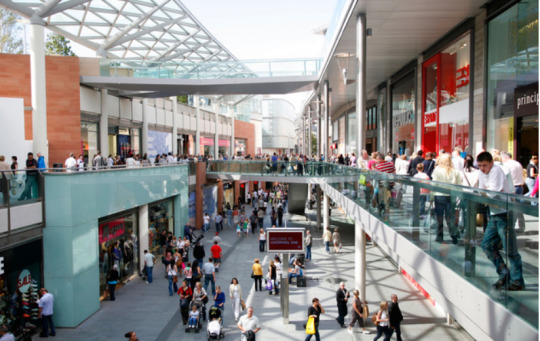
The Evolution of Local Shopping: How DASH Shop is Leading the Way
Shopping locally has always been more than just a transaction; it’s an experience. From the friendly banter with store owners to the joy of finding that perfect item, local shopping has been a cornerstone of community life. But as times have changed, so has the way we shop. Today, DASH Shop is at the forefront of this evolution, transforming local shopping into a seamless, technology-driven experience that blends the best of the past with the innovations of the future.
A Glimpse into the Past
Back in the day, local shopping was all about brick-and-mortar stores. People would stroll down Main Street, popping into their favorite shops, chatting with neighbors, and enjoying the tactile pleasure of seeing and touching products before buying them. It was a social activity, a chance to connect with others and support local businesses. However, as convenient as it was, this traditional model had its limitations. Store hours were fixed, inventory was finite, and sometimes the perfect item just wasn’t available.
The Modern Challenges
Fast forward to today, and the landscape of local shopping has drastically shifted. The rise of e-commerce giants has posed significant challenges for small, local retailers. With the convenience of online shopping, customers can browse endless aisles of products, compare prices, and have their purchases delivered right to their doorstep. This convenience has drawn many away from local shops, making it harder for small businesses to compete.
Local stores also face logistical hurdles such as managing inventory, offering competitive pricing, and meeting the high expectations of today’s consumers who demand quick, efficient service. The pandemic further accelerated these challenges, pushing even more shoppers online and leaving many local retailers struggling to stay afloat.
Enter DASH Shop: Revolutionizing Local Shopping
DASH Shop is here to bridge the gap between the traditional charm of local shopping and the modern demands of convenience and efficiency. By leveraging cutting-edge technology, DASH Shop is revolutionizing the local shopping experience in several key ways.
Instant Delivery:
One of the most significant ways DASH Shop is transforming local shopping is through its instant delivery service. Gone are the days of waiting weeks for an online order to arrive. With DASH Shop, customers can enjoy the convenience of having their purchases delivered to their doorstep within hours. This not only meets the high expectations of today’s consumers but also gives local retailers a competitive edge.
Robust Analytics:
DASH Shop provides retailers with powerful analytics tools, offering deep insights into sales trends, customer behavior, and inventory management. This data-driven approach helps retailers make informed decisions, optimize stock levels, and tailor their offerings to better meet customer needs. It’s like having a crystal ball for your business, ensuring you’re always one step ahead.
Seamless Integration:
One of the best parts about DASH Shop is its ability to integrate seamlessly with existing sales channels. Retailers don’t have to overhaul their entire system to benefit from DASH Shop’s features. Instead, the platform enhances current operations, adding value without disruption. This means smoother transitions and minimal hassle for business owners.
Community Engagement:
DASH Shop also helps retailers connect with their communities in meaningful ways. The platform supports local charities and community initiatives, fostering goodwill and strengthening community ties. By aligning with social causes, retailers can enhance their brand image and build customer loyalty.
Building Trust and Excitement
DASH Shop isn’t just a platform; it’s a movement. It’s about reimagining local shopping for the 21st century, combining the best of the old with the innovations of the new. By addressing the current challenges faced by local retailers and providing solutions that enhance the shopping experience, DASH Shop is positioning itself as a pioneer in local e-commerce.
So, whether you’re a retailer looking to boost your business or a shopper seeking convenience without compromising on community spirit, DASH Shop is here to lead the way. Join us in revolutionizing local shopping and experience the future today.
7 notes
·
View notes
Text
How Reliance Jio Coin Could Transform India's Crypto Market
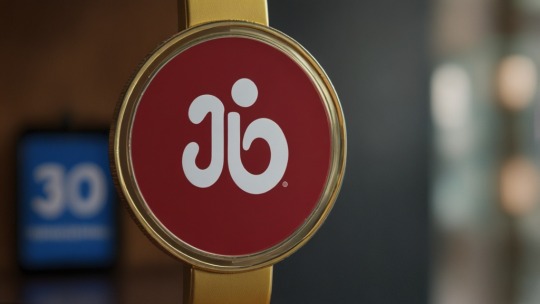
The Indian cryptocurrency market is on the verge of a major transformation, and the introduction of Reliance Jio Coin could serve as a significant catalyst. As one of India's largest conglomerates, Reliance has a history of disrupting industries, and its foray into blockchain and cryptocurrency is highly anticipated.
What Is Reliance Jio Coin?
Reliance Jio Coin is rumored to be a digital cryptocurrency developed by Reliance Jio, a subsidiary of Reliance Industries Limited (RIL). The coin aims to facilitate digital transactions, promote blockchain adoption, and potentially integrate with Jio's vast telecom and e-commerce ecosystem.
The Growing Interest in Cryptocurrency in India
India has witnessed a surge in crypto adoption, despite regulatory uncertainties. Factors such as technological advancements, increased smartphone penetration, and digital payments adoption have fueled interest in blockchain and cryptocurrency.
Potential Benefits of Jio Coin
Reliance Jio Coin could bring numerous benefits to the Indian crypto market, including:
Mass Adoption of Digital Currency – Jio has over 400 million users, providing a large user base for Jio Coin.
Blockchain Innovation – It could promote blockchain technology adoption across various industries.
Seamless Integration with Jio Platforms – Possible use cases in JioMart, JioFiber, and JioMoney.
Regulatory Compliance – Reliance’s credibility may facilitate government support.
Financial Inclusion – Can help unbanked populations participate in digital finance.
Challenges Facing Jio Coin’s Implementation
While the potential is vast, Reliance Jio Coin must overcome several challenges:
Regulatory Uncertainty – India’s stance on crypto regulations is still evolving.
User Awareness and Education – Widespread adoption requires education on cryptocurrency.
Market Volatility – Cryptocurrencies experience price fluctuations that may impact adoption.
Security Concerns – Ensuring data and transaction security is crucial.
How Jio Coin Can Shape India's Crypto Future
Reliance Jio Coin could act as a game-changer in the Indian cryptocurrency space. By leveraging Reliance's technological infrastructure, it could lead to:
Greater public trust in cryptocurrencies.
Increased innovation in decentralized finance (DeFi).
The emergence of blockchain-based government and enterprise solutions.
The Role of Blockchain in Jio Coin’s Success
Blockchain technology is at the core of any cryptocurrency. For Jio Coin to be successful, it must ensure:
Transparency – Every transaction should be recorded on a public ledger to ensure security and accountability.
Scalability – Handling large transaction volumes efficiently will be essential.
Smart Contracts – Enabling automation and reducing intermediaries in transactions.
Energy Efficiency – Exploring eco-friendly consensus mechanisms like Proof of Stake (PoS).
Possible Use Cases of Jio Coin
Jio Coin could extend beyond just a digital currency. Some potential applications include:
Retail Payments – Users may use Jio Coin for everyday transactions via JioMoney.
E-commerce Integration – JioMart could accept Jio Coin, boosting online shopping adoption.
Supply Chain Management – Blockchain-powered logistics solutions to enhance transparency.
Tokenized Assets – Real estate and stock investments via tokenization.
Loyalty Rewards – Customers could earn Jio Coin as part of promotional campaigns.
Impact on India's Digital Economy
With India's digital payment ecosystem already thriving, Jio Coin could:
Reduce dependency on traditional banking by offering decentralized financial solutions.
Encourage foreign investment in Indian blockchain startups.
Support the government’s Digital India initiative by accelerating fintech innovation.
Create new job opportunities in blockchain development, security, and compliance.
Future Roadmap for Jio Coin
If Jio Coin becomes a reality, the following steps might be taken:
Regulatory Approvals – Securing legal compliance before public launch.
Initial Pilot Programs – Testing Jio Coin with select users and businesses.
Mass Adoption Campaigns – Promoting awareness and incentivizing usage.
Expanding Use Cases – Integrating with more sectors like healthcare and education.
Global Expansion – Partnering with international crypto exchanges for trading.
Conclusion
Reliance Jio Coin has the potential to revolutionize India's crypto landscape. While challenges remain, the credibility and market dominance of Reliance Jio could pave the way for mass adoption and regulatory clarity in the sector. If executed effectively, Jio Coin could emerge as India’s leading digital currency, setting a precedent for corporate-backed cryptocurrencies.
2 notes
·
View notes
Text
The Future of E-Commerce Payment Processing Solutions
Article by Jonathan Bomser | CEO | Accept-Credit-Cards-Now.com

In the perpetually evolving world of online commerce, the importance of efficient and secure e-commerce payment processing solutions has never been more critical. As businesses adapt to the digital age, ensuring seamless transactions while mitigating risks is essential. This article delves into the future of E-Commerce Payment Processing and how it's set to revolutionize the way we conduct online transactions, from accepting credit cards for high-risk industries to providing hassle-free services like credit repair payment gateways and CBD merchant accounts.
DOWNLOAD THE FUTURE OF E-COMMERCE INFOGRAPHIC HERE
The Power of Payment Processing for High-Risk Industries
When it comes to payment processing for high-risk businesses, traditional methods often fall short. These enterprises, including those involved in credit repair, have faced numerous challenges in accepting payments. However, the future is bright as innovative high-risk merchant processing solutions are emerging. These solutions not only enable them to accept credit cards but also offer enhanced security measures, reducing the risk of fraudulent transactions. One of the key advantages of these high-risk payment gateways is their ability to tailor services to the unique needs of high-risk industries. Whether you're in the credit repair business or dealing with CBD products, having a CBD payment processing system that understands the intricacies of your industry is a game-changer.
The Convenience of Credit Card Payment Services
In the world of E-Commerce, convenience is king. Consumers expect a seamless shopping experience, which includes hassle-free payment options. This is where credit card payment services play a pivotal role. By partnering with a reliable credit and debit card payment processor, businesses can offer their customers a variety of payment methods, enhancing their shopping experience and ultimately boosting sales. The future involves cutting-edge technology that ensures the security of sensitive data. With the rise of cyber threats, consumers are more cautious than ever about sharing their financial information online. Hence, investing in a top-notch online payment gateway is not just a choice but a necessity for businesses aiming to thrive in the competitive e-commerce landscape.
Merchant Processing: A Gateway to Success
A significant component of E-Commerce Payment Processing is merchant processing. This service bridges the gap between businesses and their customers, facilitating transactions smoothly and securely. By partnering with a reputable provider, businesses can ensure that they can confidently accept credit cards for e-commerce operations without the fear of payment disruptions. For high-risk industries, such as credit repair and CBD, finding the right high-risk merchant account is crucial. This ensures that businesses can conduct their operations without unnecessary hindrances. In the coming years, we can expect to see more tailored solutions for these industries, making it easier than ever to accept credit cards for credit repair and accept credit cards for CBD products.
The Future of E-Commerce Credit Card Processing
As we look ahead, the future of E-Commerce credit card processing is rife with possibilities. The technology driving this industry forward is poised to enhance security, streamline transactions, and open new avenues for businesses. With the rapid growth of online shopping, it's essential for businesses to stay ahead of the curve. One of the most promising developments is the integration of artificial intelligence and machine learning into credit card payment processing systems. These technologies can identify patterns of fraudulent activities and protect both businesses and consumers. Additionally, they can personalize the shopping experience, making recommendations based on past purchases and preferences.
youtube
Embracing the Future of E-Commerce Payment Processing
In conclusion, the future of E-Commerce Payment Processing is bright and promising. From accepting credit cards for credit repair to providing CBD payment processing solutions, the landscape is evolving to cater to the diverse needs of businesses. As the demand for online shopping continues to grow, businesses must invest in reliable payment processing solutions to thrive. The future will see more businesses benefiting from high-risk payment gateways, ensuring that they can operate without unnecessary restrictions. Credit card payment services will continue to evolve, offering consumers a seamless and secure way to make purchases. Merchant processing will play a pivotal role in connecting businesses with their customers, enabling them to accept credit cards for e-commerce without complications.
As we embrace the technological advancements on the horizon, we can expect a safer, more convenient, and more efficient E-Commerce Payment Processing landscape. Businesses that invest wisely in these solutions will not only meet the demands of today but also be prepared for the ever-evolving future of online commerce.
#high risk merchant account#payment processing#credit card processing#high risk payment gateway#high risk payment processing#merchant processing#accept credit cards#credit card payment#ecommerce#ecommerce business#Youtube
16 notes
·
View notes
Text
An Overview of UK Home Small Domestic Appliances Market: Trends and Insights
The UK home small domestic appliances (SDA) market has seen significant growth driven by evolving consumer lifestyles, technological innovations, and a growing focus on energy efficiency and sustainability. From kettles and toasters to handheld vacuums and smart kitchen gadgets, SDAs are becoming indispensable in UK households.

Buy the Full Report for More Category Insights into the UK Home Small Domestic Appliances Market
Download a Free Sample Report
Here’s an analysis of the key trends and insights shaping the market in 2024.
1. Market Size and Growth
The SDA market in the UK is expected to grow at a CAGR of 4-6% from 2023 to 2028, driven by post-pandemic shifts in home-based lifestyles.
Rising disposable income and increasing interest in premium and smart appliances are fueling demand.
2. Key Consumer Trends
a. Smart and Connected Appliances
Voice control integration (via Alexa, Google Assistant) and IoT-enabled SDAs are gaining traction.
Popular products: Smart kettles, Wi-Fi-enabled coffee makers, and robotic vacuum cleaners.
b. Health and Wellness Focus
Growing interest in air fryers, blenders, and juicers as consumers focus on healthier lifestyles.
Increased demand for air purifiers and humidifiers due to rising concerns over indoor air quality.
c. Sustainability and Energy Efficiency
UK consumers are prioritizing eco-friendly appliances with lower energy consumption, such as energy-efficient kettles and low-wattage irons.
Brands offering repairable and recyclable products are seeing stronger loyalty.
d. Compact and Space-Saving Designs
Urban living and smaller households drive demand for multi-functional and compact SDAs, such as 2-in-1 steamers or combination microwaves.
3. Product-Specific Insights
Kitchen Appliances
Coffee Machines:
Premium brands like Nespresso and De’Longhi dominate, with demand for bean-to-cup and pod-based machines increasing.
Air Fryers:
Brands like Tefal and Ninja lead as air fryers become a household staple.
Consumers prioritize larger capacities and multi-functionality.
Cleaning Appliances
Robotic Vacuum Cleaners:
Growing adoption of smart robotic vacuums from brands like iRobot and Eufy.
Consumers value mapping technologies and self-emptying features.
Handheld Vacuums:
Brands like Dyson continue to dominate the cordless vacuum segment, driven by innovations in battery life and suction power.
Personal Care Appliances
Growth in electric toothbrushes, hair dryers, and grooming kits, driven by brand diversification and targeted marketing.
4. Retail and Distribution Trends
E-commerce Boom:
Online channels like Amazon, Argos, and Currys are witnessing robust growth, fueled by convenience and competitive pricing.
Omni-Channel Experiences:
Retailers are integrating digital and in-store experiences, such as AR demos for products.
Subscription Models:
Brands offering subscription plans for products like coffee machines and vacuum filters are seeing higher customer retention.
5. Competitive Landscape
Key Players
Dyson:
Leader in cordless vacuum and air purifier segments, with a focus on cutting-edge design and functionality.
Ninja:
Dominates the air fryer market and continues to expand into other SDAs like blenders and multi-cookers.
Philips:
Strong presence in personal care and kitchen appliances, with a growing focus on energy efficiency.
Breville:
Known for kettles, toasters, and sandwich makers, with a strong mid-market appeal.
Market Share Dynamics
Premium brands like Dyson and Nespresso dominate the high-end segment.
Mid-range brands (e.g., Tefal, Morphy Richards) maintain steady growth by balancing affordability and quality.
New entrants offering smart or niche eco-friendly solutions are gradually gaining market share.
6. Challenges and Opportunities
Challenges
Economic Pressures:
Inflation and rising energy costs may deter discretionary spending on premium SDAs.
Supply Chain Disruptions:
Component shortages and logistical issues continue to affect manufacturing and delivery timelines.
Opportunities
Sustainability:
Brands investing in energy-efficient and recyclable products are likely to capture eco-conscious consumers.
Customization:
Offering customizable products (e.g., personalized coffee settings or modular vacuum components) can differentiate brands.
7. Future Outlook
Smart Home Integration:
Growth in smart home adoption will drive demand for IoT-enabled SDAs.
Health and Wellness Products:
Continued interest in products supporting healthy lifestyles, such as air purifiers and low-fat cooking appliances.
Sustainability Leadership:
Companies embracing circular economy principles will gain a competitive edge.
The UK small domestic appliances market is poised for steady growth, underpinned by consumer preferences for convenience, sustainability, and technology-driven innovation. Players who align their strategies with these evolving trends will be best positioned to thrive.
2 notes
·
View notes
Text
Sachin Dev Duggal | Using NLP to enhance customer experience in e-commerce
In the boom of e-commerce, it is known that focusing on an exceptional customer experience is crucial. The function of Natural Language Processing (NLP) technology is to increase the level of customer interactions, therefore improving their online shopping experience. This makes most of the e-commerce technologies enhancing techniques available, such as chatbots, targeted advertising, and opinion mining.
Enhancing Customer Interactions with Chatbots
E-commerce has witnessed a significant use of NLP in the form of chatbots. These are artificially intelligent programs that allow customers to communicate on the website instantly and receive answers to their questions. Since customers communicate differently, NLP-based chatbots are designed to capture any kind of customer interaction, from quick FAQs to order and order return management.
Sachin Dev Duggal Founded Builder.ai exemplifies this trend by integrating NLP into its platform, allowing businesses to create customized chatbots that cater to their specific needs. Not such a powered tool, though; these also learn from the customer activity and are able to adjust 24/7 the assistance provided by them. Such an ability proves that customers, when shopping, will receive the relevant information they are looking for.
Personalized Recommendations
NLP’s ability to provide personalization is another area that cannot be overlooked. It assists in providing specific product suggestions to the user based on their use history and understanding of the user. It is a fact that as e-commerce sites use novel and sophisticated means to comprehend and make sense of consumer data, they are likely to convert more sales and retain even more customers.
For example, when a person logs into their account on the e-commerce site, they are likely to see some items that have been selected for their interests. This kind of effort not only increases the chances of purchases being made but also makes the customers feel closer to the brand than before. Organizations such as Builder.ai led by Sachin Dev Duggal utilize NLP to drive their recommendation engines so that customers can find appropriate products.
Sentiment analysis for better insights
Another common application of NLP is sentiment analysis, which is quite beneficial in that it helps e-commerce companies assess the feelings of their customers towards their goods or services. Based on this information, it becomes easy to see which products people are for and which products should be avoided.
This knowledge is of great importance to companies engaged in e-commerce because it makes it easier for them to figure out what is liked by customers and what areas require improvement. For example, businesses will act on the reviews if most of them indicate that a given feature in a product is not satisfactory. Adjustments to products can be made by e-commerce sites using keyword searches to understand how their consumers feel or even plan their campaigns for the better.
Predicting Market Trends and Consumer Behavior
Apart from enhancing the manner of dealing with customers, NLP may also be used in predicting the general behaviour of the market and that of the consumer. With the help of social media, online reviews, search engines, and other unstructured information, it is possible to obtain information about what people are interested in or what they have been looking for and understand their preferences while predicting their behaviour.
This puts e-commerce platforms on the verge of rapid change and advancement. Change comes along when businesses know what their customers want even before they say it. Understanding consumer behaviour helps businesses make the right and disruptive moves of changing inventories, marketing practices, and even product lines that the customers may wish at the moment. Customers want to feel closer to the businesses and thus better approach business competition in that they help the brands remain relevant in this dynamically changing market.
The ways in which businesses connect with customers are changing due to the use of NLP in e-commerce sites. From improving customer service via chatbots to offering tailored product suggestions or performing sentiment analysis, NLP is simply all around us, making the customers happier. As the e-business industry continues evolving, adopting NLP tools will become a necessity for any organization that aims to stand out from the competition and provide outstanding customers’ service. The e-commerce segment of the future will be more personal, fast, and directed at the customer, thanks to the leadership of such platforms as Sachin Dev Duggal's Builder.ai.
#artificial intelligence#AI#technology#sachin dev duggal#sachin duggal#builder.ai#builder ai#sachin dev duggal news#sachin duggal news#builder.ai news#builder ai news#sachin dev duggal builder.ai#sachin duggal builder.ai#AI news#tech news#sachindevduggal#innovation#sachinduggal#sachin dev duggal ey
2 notes
·
View notes
Text
Small Business Website Hosting and Management Services
Running a small business in today’s digital age requires having a strong online presence. One crucial aspect of establishing that presence is having a well-designed and functional website. However, building and maintaining a website can be a daunting task, especially for small business owners who may not have the technical expertise or resources to handle it themselves. That’s where small business website hosting and management services come into play.

What is Small Business Website Hosting?
Website hosting is the process of storing and making your website accessible on the internet. Small business website hosting services provide the infrastructure and technology needed to keep your website up and running smoothly. They offer server space, domain registration, email accounts, and other essential features to ensure your website is available to visitors around the clock.
Choosing the right hosting service for your small business is crucial. Factors to consider include reliability, speed, security, customer support, scalability, and affordability. Small business website hosting services understand the unique needs of small enterprises and offer plans tailored to their requirements.
Benefits of Small Business Website Hosting Services
1. Technical Expertise: Small business website hosting services have a team of professionals who possess the necessary technical skills and experience to handle website management effectively. They take care of tasks such as server maintenance, software updates, and security patches, allowing you to focus on running your business.
2. Reliability and Uptime: Small business hosting services ensure that your website is always available to visitors. They have robust infrastructure and backup systems in place to minimize downtime and provide a reliable online experience for your customers.
3. Scalability: As your small business grows, so does your website’s needs. Hosting services offer scalable solutions that can accommodate increased traffic, storage, and functionality requirements. This flexibility allows your website to expand alongside your business without disruptions.
4. Security: Website security is of paramount importance in today’s digital landscape. Small business website hosting services implement robust security measures to protect your website from hacking attempts, malware, and other cyber threats. They often provide SSL certificates, regular backups, and firewall protection to safeguard your data and your customers’ information.
5. Support: Small business hosting services offer dedicated customer support to assist you with any technical issues or questions you may have. This ensures that you have reliable assistance whenever you encounter challenges with your website.
Website Management Services
In addition to website hosting, many small business hosting services also offer website management services. These services take care of the day-to-day tasks involved in maintaining and updating your website, freeing up your time to focus on your core business activities.
Website management services may include:
– Content updates and modifications
– Regular backups and data protection
– Performance monitoring and optimization
– Search engine optimization (SEO)
– Design and layout enhancements
– Integration of new features and functionality
– E-commerce solutions
By outsourcing website management to professionals, small business owners can ensure that their website remains current, engaging, and fully functional without the need for in-house technical expertise.
Choosing the Right Small Business Website Hosting and Management Service
When selecting a small business website hosting and management service, it’s essential to consider your specific needs and goals. Evaluate factors such as pricing, features, customer reviews, and the provider’s reputation in the industry.
Additionally, assess the scalability of the service to ensure it can grow with your business. Look for a service that offers reliable customer support and has a track record of high uptime and security. Ultimately, the right service will empower your small business to establish a strong online presence and thrive in the digital marketplace.
In conclusion, small business website hosting and management services play a vital role in helping small enterprises establish and maintain a robust online presence. By providing reliable hosting, technical expertise, security, and website management solutions, these services enable small business owners to focus on what they do best while leaving the website-related tasks to professionals. With the right hosting and management service, small businesses can compete effectively in the digital realm and reach their target audience with a compelling and functional website.

source
#WebManagement#ServerHosting#WebsiteMaintenance#TechSupport#CloudHosting#DataCenter#ServerManagement#WebHosting#ITInfrastructure#WebsiteSecurity#ServerAdmin#HostingSolutions#WebsitePerformance#ServerMonitoring#WebDevelopment#CloudComputing#NetworkSecurity#DomainRegistration#BackupandRecovery#Cybersecurity
18 notes
·
View notes
Text
Premarket U.S. Stock Movers: Tesla, Macy’s, Coinbase, Nio, Shell, Amazon

In today's early trading, the U.S. stock market is already buzzing with notable movements among key players. Investors and analysts are closely monitoring the premarket activity of several prominent stocks, each showing distinctive performance dynamics.
Tesla (NASDAQ) has started the day on a positive note, with its stock rising by 1.8%. This upward movement follows recent market optimism surrounding Tesla's innovative developments in electric vehicles and sustainable energy solutions. As a pioneering force in the automotive industry, Tesla continues to capture investor interest with its innovative technological advancements and ambitious growth strategies.
Macy’s (NYSE) is another standout performer in the premarket, showcasing a robust 6.8% increase. This surge reflects renewed investor confidence in the retail giant's ability to navigate challenges and capitalize on evolving consumer trends. Macy's ongoing efforts to enhance its digital capabilities and strategic initiatives in omnichannel retailing are positioning the company for sustained growth in a competitive market landscape.
Coinbase (NASDAQ), however, faces a 4.6% decline in its premarket trading. The cryptocurrency exchange platform is experiencing volatility amidst regulatory scrutiny and market fluctuations in digital assets. Despite its leadership in the digital currency space, Coinbase's stock performance underscores the inherent volatility and regulatory uncertainties impacting the crypto industry.
Nio (NYSE), known for its electric vehicle offerings, is witnessing a 2.3% decrease in its American Depositary Receipts (ADRs) during premarket trading. This decline comes amid broader sectoral challenges and market sentiment towards growth stocks in the EV sector. Nio continues to navigate through supply chain disruptions and competitive pressures as it strives to expand its market presence globally.
Shell (LON) ADRs, representing Royal Dutch Shell, have shown a modest 1.1% rise in premarket trading. As a global energy leader, Shell's stock performance reflects investor sentiment toward energy markets and macroeconomic factors influencing oil and gas prices. The company's strategic focus on sustainable energy transitions and operational resilience in a dynamic energy landscape remains pivotal amid evolving market conditions.
Amazon (NASDAQ), a cornerstone of e-commerce and cloud computing services, is demonstrating a minor 0.3% change in its premarket activity. Amazon's stock movement reflects ongoing investor sentiment towards tech giants amid regulatory scrutiny and competitive pressures in digital retail and cloud computing markets. The company continues to innovate across its business segments, driving growth and adaptation to evolving consumer behaviors.
Today's premarket movements highlight the diverse dynamics shaping the U.S. stock market. Investors are navigating through a mix of sector-specific trends, regulatory developments, and macroeconomic factors influencing stock performance. As market participants analyze these early signals, the day's trading session promises to offer further insights into the evolving landscape of global financial markets.
3 notes
·
View notes
Text
History Disrupted, a fairly recent book about history, makes some great points about how historians face the classic “intrinsic vs extrinsic” tug of war. This reminded me of a couple weeks ago when my sophomore students started a unit that focused a lot on material wealth and they were stumped by these terms. The best explanation we got was that intrinsic= experience and extrinsic=material wealth. This is also true with history; historians value intrinsic knowledge while e-history, the internet’s version of history, goes for extrinsic.
Historians are intrinsic because they’re looking to the people who have spent time attending seminars and writing papers for conferences and getting neck deep in the previously published expertise for whatever they’re interested in. If I’m a grad student interested in the French Revolution who wants to make new discoveries and arguments about the French Revolution, I’ve got to know what the previous arguments are. Getting familiar with these previous works and finding the gaps in knowledge is a marathon, not a sprint. You have to get comfortable with a field, publish your discoveries, get peer reviewed, and then you’re able to make reliable historical arguments on the internet, from historians’ perspective.
The internet’s take on who’s qualified to do E history is fundamentally extrinsic; it values the people who are getting attention and making money on whatever site or app is being used to spread the information. The heads of internet companies aren’t worried about credentials or experiences, they want clickbait, buzzwords, provocation. It is history as commerce and the academics of it all is nobody’s concern. As someone who values history and aspires to be a respected historian, it’s not encouraging stuff. This is a culture that favors reactions over nuance and those two things almost never mix.
4 notes
·
View notes
Text
Fintech Market Growth Prospects for and Beyond

The realm of financial technology (fintech) is a dynamic ecosystem continuously evolving with technological advancements and market demands. As we traverse through the digital age, the fintech market emerges as a focal point of innovation and disruption. In this discourse, we explore the growth prospects of the fintech market, with a keen eye on the transformative endeavors of Xettle Technologies, and envisage its trajectory for the present and beyond.
The Ascendant Trajectory of the Fintech Market
The fintech market has witnessed exponential growth in recent years, fueled by technological innovation, shifting consumer preferences, and regulatory reforms. From mobile payments and digital banking to blockchain-powered solutions and artificial intelligence (AI) algorithms, fintech encompasses a diverse array of services reshaping the financial landscape. With increasing digitization and the proliferation of internet connectivity, the fintech market is poised for sustained expansion globally.
Key Drivers of Growth
Several factors underpin the growth of the fintech market, chief among them being the rising adoption of digital banking and payment solutions. As consumers gravitate towards convenience and accessibility, traditional banking models are being supplanted by digital alternatives, driving the uptake of fintech services. Moreover, the democratization of financial services through fintech platforms fosters financial inclusion, empowering underserved populations with access to banking and investment opportunities.
Additionally, the convergence of fintech with emerging technologies such as blockchain, AI, and machine learning amplifies its transformative potential. Blockchain, in particular, revolutionizes traditional financial systems by enhancing security, transparency, and efficiency. Xettle Technologies stands at the forefront of this convergence, leveraging blockchain to pioneer innovative solutions in lending, payments, and decentralized finance (DeFi), thereby catalyzing market growth and fostering financial inclusion.
Global Expansion and Market Penetration
The fintech market's growth extends beyond traditional financial hubs, permeating emerging markets and underserved regions. In developing economies, where banking infrastructure is nascent or inaccessible, fintech bridges the gap by offering mobile-based banking, microfinance, and digital payment solutions. Xettle Technologies exemplifies this trend through its expansion into emerging markets, offering inclusive financial services tailored to local needs and preferences, thereby capturing untapped market segments and driving revenue growth.
Regulatory Landscape and Compliance
While regulatory frameworks pose challenges to fintech innovation, they also serve as catalysts for market maturity and stability. Regulatory compliance is paramount for fintech firms to ensure consumer protection, data privacy, and financial integrity. Xettle Technologies navigates the regulatory landscape adeptly, collaborating with regulatory bodies to ensure compliance while driving innovation in blockchain-based financial solutions. By adhering to regulatory standards and fostering trust among stakeholders, fintech firms can mitigate risks and unlock new growth opportunities.
Future Trajectory and Emerging Trends
Looking ahead, the financial industry is poised for continued expansion and disruption, driven by evolving consumer behaviors and technological advancements. AI and machine learning algorithms will play an increasingly integral role in personalizing financial services, risk assessment, and fraud detection. Moreover, the convergence of fintech with sectors like e-commerce, healthcare, and real estate presents new avenues for market expansion and diversification.
Furthermore, decentralized finance (DeFi) represents a burgeoning frontier in the fintech landscape, leveraging blockchain technology to create open, permissionless financial systems. Xettle Technologies leads the charge in DeFi innovation, developing decentralized lending platforms, liquidity pools, and yield farming protocols, thereby democratizing access to financial services and disrupting traditional banking models.
Conclusion
In conclusion, the fintech market's growth prospects for and beyond are characterized by innovation, disruption, and inclusivity. As fintech firms continue to harness technological advancements and adapt to evolving regulatory landscapes, they will unlock new growth opportunities and redefine the financial services industry. Xettle Technologies, with its pioneering spirit and commitment to innovation, exemplifies the transformative potential of fintech in driving financial inclusion, market expansion, and economic empowerment on a global scale. As we embark on this journey of innovation and disruption, the future of fintech is brimming with possibilities, poised to reshape the financial landscape for generations to come.
#Fintech Marketing#Fi̇ntech#Startup#Technology#Fintech App Development#fintech#fintech software#marketing#xettle technologies
2 notes
·
View notes